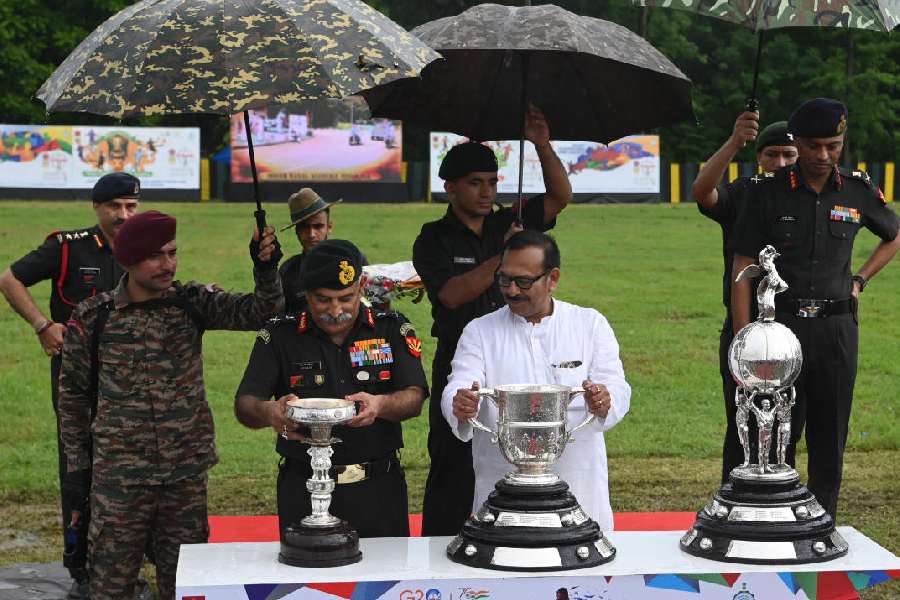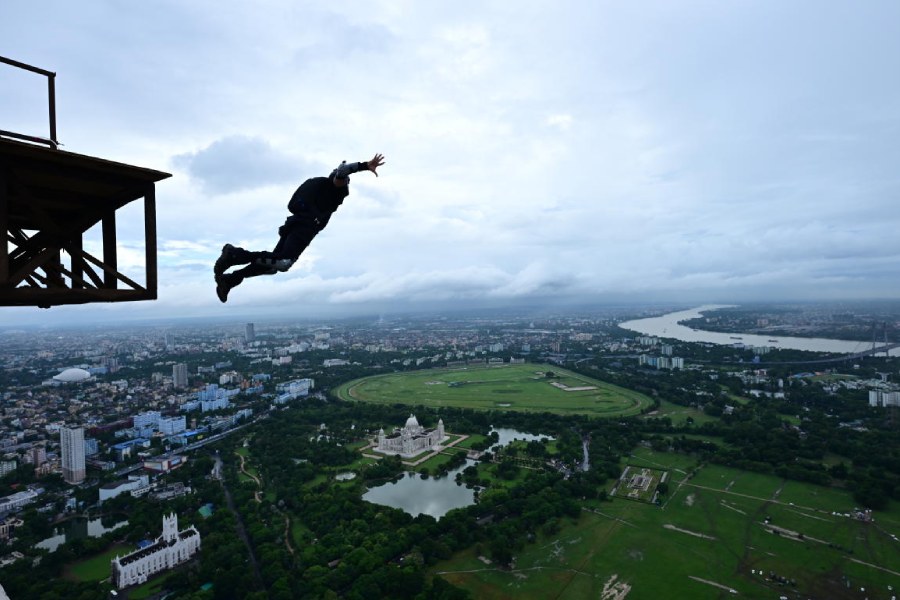Is it a bird? Is it a plane? No.
On Tuesday, the Calcutta sky saw something it never has.
Two men jumped, one after another, from the roof of the tallest building in the city — around 870ft from the ground — and landed gently on a slice of the rain-soaked Maidan.
A few hundred people, who braved the persistent rain, let out a collective shriek after each jump. The anxiety turned into loud cheers as the men opened their parachutes and landed.
Group Captain Kamal Singh Oberh (retd) and Lt Col Satyendra Verma (retd) performed what was billed as the first two BASE jumps in Calcutta.
BASE jumping is an extreme adventure sport that sees athletes jump off a fixed structure. BASE is an acronym for building, antenna, span (usually referring to bridges) and the Earth (vertical mountain cliffs) — the four types of fixed objects athletes leap from.
BASE jumping is similar to skydiving in the sense that in both, jumpers use a parachute to arrest their fall. But unlike usual skydivers, BASE jumpers do not jump off an aircraft.
On Tuesday, the jump was delayed by rain and occasional streaks of lightning.
Oberh went first. Standing on a temporary structure — which served as a springboard — on the roof of the 65-storeyed The 42, on Chowringhee, he looked like a dot in the sky.
He jumped at 4.12pm. The chute opened a couple of seconds later, when he was almost parallel to the third floor from the top. He glided past some of the iconic structures and moved forward.
For a few seconds, it seemed he glided beyond the landing spot on Brigade Parade Ground, on the northeast corner of the musical fountain. But he moved in the air with dexterity and made what looked like a sharp U-turn on an empty road and landed exactly where he was supposed to. All in 64 seconds.
“This is the mark of a true master in the world of BASE jumping,” an army commentator said on the microphone.
Oberh holds several Indian records as a skydiver. He has dived over both the North Pole and Antarctica. Since his first in 2005, he has had over 150 BASE jumps to his credit.
Oberh has jumped from structures in Malaysia, Switzerland, Brazil and India.
As he landed, army officers ran towards him and hugs and high-fives followed.

Aroop Biswas, Bengal’s sports minister, and Lt Gen RP Kalita, General Officer Commanding-in-Chief, Eastern Command, with the Durrand trophies on the Maidan on Tuesday afternoon. Sanat Kr Sinha
Verma stepped on the board around 4.25pm. On two occasions, he seemed ready to take the leap but stepped back. “Some live on the edge, some step over it,” said Oberh, who had by then donned the commentator’s role.
Verma eventually jumped at 4.29pm. His leap followed the same trajectory as that of Oberh. From leap to landing, he took 66 seconds.
“On the roof, I stepped back because of the gusts of wind from the rear. I was waiting for a window, a brief lull in the winds. I jumped as soon as I got one,” said Verma, who started skydiving in 1993 and then transitioned to BASE jumping in 2009. His first jump was from KL Tower in Malaysia. Since then, he has BASE-jumped from all four platforms, in India and abroad.
The two jumps were part of a promotional campaign in the run-up to the Durand Cup, a football tournament jointly organised by the Indian Armed Forces and the Bengal government. Established in 1888, the Durand Cup is Asia’s oldest football tournament.
After a 14-city tour, the trophies arrived in Calcutta on Tuesday. The tour included “some of the most prominent and picturesque Tri-Service bases as well as the home of the defending champions Bengaluru FC and the two other host cities of Guwahati and Kokrajhar,” the army said in a release.
On the Maidan on Tuesday, the trophies were received and “flagged-in” by Aroop Biswas, Bengal’s sports minister, and Lt. Gen. R.P. Kalita, General Officer Commanding-in-Chief, Eastern Command.
The jump was to have taken place anytime between 2.30pm and 3.30pm, based on the wind speed and direction. The weather delayed the spectacle. But the crowd stayed on.
The wait paid rich dividends. “This is a lifetime experience,” said Mukhesh Goyal, who was among the residents of The 42 who watched the spectacle.
